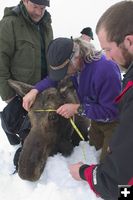

Measuring a Moose
Dr. Joel Berger makes measurements on a tranquilized cow moose in February 2004 near Moran, WY. Photo by Mark Gocke, WGFD.
|
|
Moose study underway near Jackson
G&F, WYDOT to study Moose movements
by Wyoming Game & Fish Department
February 7, 2005
As Wyoming continues to contend with a dwindling Jackson moose population, researchers with the Game and Fish Department hope a new study will provide some answers. Biologists involved in the study, funded in part by the Wyoming Department of Transportation, will fit about 40-45 moose with Global Positioning System (GPS) radio collars to provide a continuous stream of data on the animals' movements over the next two years.
The study is being initiated as the Game and Fish plans to propose closing the hunting season for next fall in Moose Hunt Areas 7, 14, and 32 in the Teton Wilderness. "To this point, our only tool to help this herd has been to reduce the hunting pressure, said Jackson Wildlife Biologist Doug Brimeyer. "We've been reducing the number of permits in the Teton Wilderness hunt areas for over 10 years now, but the population has continued to decline." The Game and Fish has cut the number of hunting permits in the Jackson moose herd unit from a high of 495 in 1991 to just 75 for 2004.
This study comes on the heels of previous research done on Jackson moose by Dr. Joel Berger with the Wildlife Conservation Society. "We got some good information from Joel's work and we are utilizing his data to formulate a fine scale movement and survival study of those animals that winter in the Buffalo Valley area," said Brimeyer. "This study calls for collaring more animals of both sexes, which should give us a more comprehensive look at the herd."
This study is being made possible through the WYDOT partnership. WYDOT contributed $50,000 to help make the study happen.
"There's been wildlife concerns raised over the planned reconstruction of US 26/287 over Togwotee Pass," said WYDOT spokesman Cody Beers. "We share those concerns and want to rebuild the highway with the least impact on the local wildlife. This moose movement study should help us do that, while gaining valuable information about how the moose in Buffalo Valley react to the highway and the highway improvement project."
"The bottom line is, there's still a lot of speculation out there as to why our moose population continues to decline," says Brimeyer. "Some say it predators, some says it habitat, drought or poor nutrition. At this point we really don't know. Often times it's a combination of factors, but until we sort these things out we won't know how to best address the problem."
|
